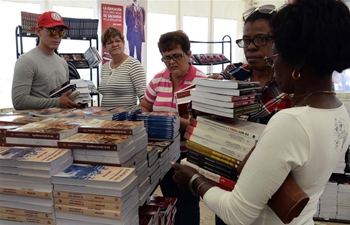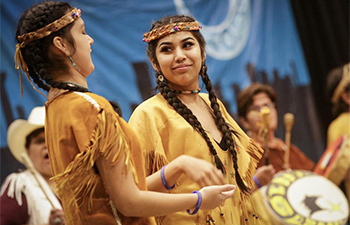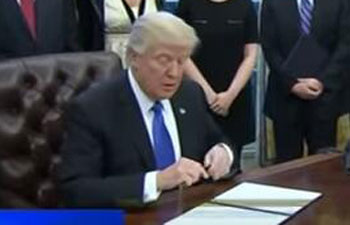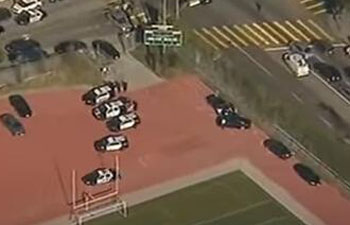By Julia Pierrepont III
SANTA BARBARA, the United States, Jan. 4 (Xinhua) -- "The past few months have been some of the hardest for everyone in Santa Barbara. The devastation and the emotional toll it has taken on all of us is not quantifiable..."
Roger Durling, executive director of the Santa Barbara Film Festival, told Xinhua Sunday, on a sunny spring day in the Southern California.
In the wake of the back-to-back tragedies of massive wildfires, floods and mudslides, the beautiful seaside community of Santa Barbara, known as the American Riviera, has been battling for the last month to regain its footing and rise from the ashes.
Though the City of Santa Barbara itself was largely untouched, the neighborhood of Montecito is still reeling from the loss of dozens of homes and 23 lives.
Many assumed that the annual Santa Barbara Film Festival would be yet another casualty. But Santa Barbarans are made of sterner stuff.
In a rousing speech before a packed Opening Night Ceremony audience last Wednesday, Durling promised, "Film has the power to unify us, to make us feel less fragmented as human beings. The events of the past weeks have fragmented this community. We've felt alone. But tonight, and for the next 10 days, we're alone no more."
Emilio Estavez, whose film, "The Public" had its world premier on Opening Night, told Xinhua, "Santa Barbara needs this now more than ever. The film deals with... the people who are struggling and this community knows something about that now in ways no one could have imagined."
He went on to say, "Yet out of this tragedy come miracles...big and small. And this festival is one of the many miracles of this city."
Community and cooperation were strong refrains that ran throughout many of the festival films this year. Multiple Emmy, SAG and Golden Globe Award winner, Alec Baldwin, who co-starred in Estevez's film, told Xinhua, "The direction we have to go in, not just this country but the world, is: we have to share more...we have to make room for everyone."
Three powerful, eye-opening documentaries on climate change and the global environmental crisis also highlighted the theme of social responsibility as they led the call for socio-environmental action:
"Acid Horizon", directed by Ivan Hurzeler, follows Dr. Erik Cordes, a Temple University oceanographic ecologist, and his intelligent analysis of our ocean' s decline into acidity, with coherent potential solutions.
"Living in the Future's Past", narrated by Santa Barbara resident, Jeff Bridges, and directed by Susan Kucera, is a visually stunning look inside the human behavior that motivates societies obsession with energy.
"Metamorphosis" is a 4K visual stunner and a more hopeful than the others, as it takes viewers through a magnificent panoply of breathtaking, planet-wide images from California, the Canary Islands, Vanuatu, Canada's Badlands of Alberta, etc., that prove the powerful resilience of the planet.
With more than 150 films on deck to choose from during the 10-day event, there is literally something for everyone, but a few films of special note were:
"Oh Lucy," a quirky, Asian-centric ode on loneliness and being true to one's self, starring Josh Harnett and Sinobu Terajima, by Japanese director, Atsuko Hirayanagi.
"Scary Mother", the feature debut of Georgian writer/director, Ana Urushadze, and a tightly-written mix of horror, love, humor around a classic dysfunctional family.
"Sunshine That Can Move Mountains," Han Chinese filmmaker, Wang Qiang's, poetic and sensitive take on the introspective life of an itinerant Buddhist monk as he journeys through the vast, rural landscapes of Tibet to reach home.
More than just an ambitious festival that showcases dozens of world and US premieres each year, when needed most, this year's Santa Barbara Film Festival stepped up to become a symbol of hope to the city's strong, vibrant community.
Cathy Murillo, the first female Latina mayor of a major city in California, attributes that to the "healing power of shared culture. The festival is a positive move that helps people in grief move through to catharsis."
A newcomer to City Hall, her first day in office was Jan. 9, the day the skies opened over Santa Barbara and poured death and destruction down upon her community.
With the surrounding hillsides denuded by the largest wildfire in California history, there was nothing to hold the fragile earth in place. Torrential downpours sent a crushing wave of mud and debris over parts of Montecito, killing almost two dozen in their sleep.
"As a mayor in California, I knew there was bound to be a natural disaster on my watch, but I never expected something as biblical as this," said Mayor Mullio ruefully in an exclusive interview with Xinhua on Friday.
"But, we have the best First Responders in the country. City, country, state, all under one incident command, all highly-trained for emergencies just like this."
"But now, after mourning our dead, Santa Barbara is in recovery and rebuilding," she told Xinhua. "Tourism is the lifeblood of Santa Barbara, and will play a large part in supporting our local businesses and getting us back to normal. Santa Barbara is famous for its pristine, coastal beauty. That hasn't changed."
When asked how others could help the city recover, Mayor Murilla said, "For anyone who wants to help Santa Barbara, we invite you to come visit us. Come see our beautiful beaches and clear blue skies. Our delicious restaurants and fine universities. Be part of Santa Barbara again."
Roger Durling had the last word, "The Santa Barbara community built this film festival in 1986. And their love and pride grew it into what it is today. Movies have always had an immeasurable power to heal. As Santa Barbara recovers, we welcome and encourage film lovers and visitors to gather around our strong, beautiful and resilient community."













